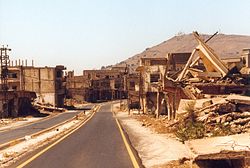Quneitra: Difference between revisions
m format |
No edit summary |
||
| Line 3: | Line 3: | ||
[[Image:Qunaitra.jpg|250px|right|thumb|The town of Al-Qunaytirah in September 2001]] |
[[Image:Qunaitra.jpg|250px|right|thumb|The town of Al-Qunaytirah in September 2001]] |
||
'''Quneitra''' or '''Al Qunaytirah'''' ([[Arabic language|Arabic]] القنيطرة) is a city of southwestern [[Syria]] that is now largely abandoned. It lies in the UN-monitored demilitarized zone between Syria and [[Israel]]. The city was a commercial and cultural hub for southwestern Syria until the [[Six-Day War]], when |
'''Quneitra''' or '''Al Qunaytirah'''' ([[Arabic language|Arabic]] القنيطرة) is a city of southwestern [[Syria]] that is now largely abandoned. It lies in the UN-monitored demilitarized zone between Syria and [[Israel]]. The city was a commercial and cultural hub for southwestern Syria until the [[Six-Day War]], when Syria attacked Israel, and consequently lost the [[Golan Heights]]. The city was placed back under Syria's control for a short while in the [[Yom Kippur War]], but Israel recaptured it. |
||
An [[Israeli settlement]] named Keshet was established nearby by [[Gush Emunim]] without governmental approval, and was later relocated as Israel withdrew from the city in 1974. Syria claims that Israel deliberately destroyed |
An [[Israeli settlement]] named Keshet was established nearby by [[Gush Emunim]] without governmental approval, and was later relocated as Israel withdrew from the city in 1974. However, Syria chose not to resettle or rebuild the city. Syria claims that Israel deliberately destroyed Quneitra, and systematically stripped it of its usefulness but Israel claims that the city was destroyed in the fighting from both sides. The General Assembly of the United Nations condemned what it saw as Israel's role in the destruction of the city in Resolution 3240 dated [[29 November]] [[1974]]. Israel viewed this condemnation as political and one-sided. |
||
Since [[2005]], Syria has pledged to reconstruct the city. It has started construction projects which include a multi-million dollar hospital and a new highway from [[Damascus]] to Al Qunaytirah. |
Since [[2005]], Syria has pledged to reconstruct the city. It has started construction projects which include a multi-million dollar hospital and a new highway from [[Damascus]] to Al Qunaytirah. |
||
| Line 15: | Line 15: | ||
Tradition holds that [[Paul of Tarsus|Saint Paul]] passed through Qunaytirah on his way from Damascus to [[Jerusalem]]. The city was home to an important [[Greek Orthodox]] church until the Six Day war. Syria claims Israel destroyed and robbed the church [http://www.tzemachdovid.org/Facts/camera6.shtml], while Israel claims that the town, including the church, was destroyed by Syrian artillery during and before the [[Yom Kippur War]][http://www.tzemachdovid.org/Facts/camera6.shtml]. |
Tradition holds that [[Paul of Tarsus|Saint Paul]] passed through Qunaytirah on his way from Damascus to [[Jerusalem]]. The city was home to an important [[Greek Orthodox]] church until the Six Day war. Syria claims Israel destroyed and robbed the church [http://www.tzemachdovid.org/Facts/camera6.shtml], while Israel claims that the town, including the church, was destroyed by Syrian artillery during and before the [[Yom Kippur War]][http://www.tzemachdovid.org/Facts/camera6.shtml]. |
||
Al Qunaytirah is also the name of a governorate of southwestern Syria that |
Al Qunaytirah is also the name of a governorate of southwestern Syria that included the Israeli [[Golan Heights]]. The legal status of the territories is discussed in [[International law and the Arab-Israeli conflict|here]]. |
||
==Destruction== |
==Destruction== |
||
Revision as of 16:39, 14 February 2006

Quneitra or Al Qunaytirah' (Arabic القنيطرة) is a city of southwestern Syria that is now largely abandoned. It lies in the UN-monitored demilitarized zone between Syria and Israel. The city was a commercial and cultural hub for southwestern Syria until the Six-Day War, when Syria attacked Israel, and consequently lost the Golan Heights. The city was placed back under Syria's control for a short while in the Yom Kippur War, but Israel recaptured it.
An Israeli settlement named Keshet was established nearby by Gush Emunim without governmental approval, and was later relocated as Israel withdrew from the city in 1974. However, Syria chose not to resettle or rebuild the city. Syria claims that Israel deliberately destroyed Quneitra, and systematically stripped it of its usefulness but Israel claims that the city was destroyed in the fighting from both sides. The General Assembly of the United Nations condemned what it saw as Israel's role in the destruction of the city in Resolution 3240 dated 29 November 1974. Israel viewed this condemnation as political and one-sided.
Since 2005, Syria has pledged to reconstruct the city. It has started construction projects which include a multi-million dollar hospital and a new highway from Damascus to Al Qunaytirah.
Religious importance

Tradition holds that Saint Paul passed through Qunaytirah on his way from Damascus to Jerusalem. The city was home to an important Greek Orthodox church until the Six Day war. Syria claims Israel destroyed and robbed the church [1], while Israel claims that the town, including the church, was destroyed by Syrian artillery during and before the Yom Kippur War[2].
Al Qunaytirah is also the name of a governorate of southwestern Syria that included the Israeli Golan Heights. The legal status of the territories is discussed in here.
Destruction
In a "Report of the Security Council commission" established under resolution 446, Yassin Rikab, a witness called in by Mr. Najib Al Ahmad, Special Representative of Palestine Liberation Organization (PLO), testified about Israel's alleged destruction of the city before withdrawal:
At the beginning of June 1974, the witness had visited the city of Quneitra, where he saw a large number of Israeli bulldozers destroying the town and the surrounding areas. [3]
Israel, on the other hand, claims that the town was destroyed by Syrian artillery during and before the Yom Kippur War.
Also, The New York Times on October 21 1973 referred to Quneitra as "a bombed-out military town the Syrians lost to the Israelis ..."[4]
